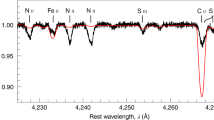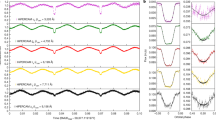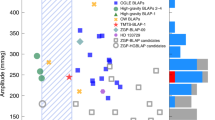Abstract
The nuclear bulge is a region with a radius of about 200 parsecs around the centre of the Milky Way1. It contains stars with ages2,3,4 ranging from a few million years to over a billion years, yet its star-formation history and the triggering process for star formation remain to be resolved. Recently, episodic star formation, powered by changes in the gas content, has been suggested5. Classical Cepheid variable stars have pulsation periods that decrease with increasing age6, so it is possible to probe the star-formation history on the basis of the distribution of their periods7,8. Here we report the presence of three classical Cepheids in the nuclear bulge with pulsation periods of approximately 20 days, within 40 parsecs (projected distance) of the central black hole. No Cepheids with longer or shorter periods were found. We infer that there was a period about 25 million years ago, and possibly lasting until recently, in which star formation increased relative to the period of 30–70 million years ago.
This is a preview of subscription content, access via your institution
Access options
Subscribe to this journal
Receive 51 print issues and online access
$199.00 per year
only $3.90 per issue
Buy this article
- Purchase on Springer Link
- Instant access to full article PDF
Prices may be subject to local taxes which are calculated during checkout



Similar content being viewed by others
References
Launhardt, R., Zylka, R. & Mezger, P. G. The nuclear bulge of the Galaxy. III. Large-scale physical characteristics of stars and interstellar matter. Astron. Astrophys. 384, 112–139 (2002)
Serabyn, E. & Morris, M. Sustained star formation in the central stellar cluster of the Milky Way. Nature 382, 602–604 (1996)
van Loon, J. Th. et al. Infrared stellar populations in the central parts of the Milky Way galaxy. Mon. Not. R. Astron. Soc. 338, 857–879 (2003)
Figer, D. F., Rich, R. M., Kim, S. S., Morris, M. & Serabyn, E. An extended star formation history for the Galactic Center from Hubble Space Telescope NICMOS observations. Astrophys. J. 601, 319–339 (2004)
Yusef-Zadeh, F. et al. Star formation in the central 400 pc of the Milky Way: Evidence for a population of massive young stellar objects. Astrophys. J. 702, 178–225 (2009)
Bono, G. et al. Classical Cepheid pulsation models. X. The period-age relation. Astrophys. J. 621, 966–977 (2005)
Alcock, C. et al. The MACHO project LMC variable star inventory. VIII. The recent star formation history of the Large Magellanic Cloud from the Cepheid period distribution. Astron. J. 117, 920–926 (1999)
Meschin, I., Gallart, C., Aparicio, A., Cassisi, S. & Rosenberg, A. Cepheid variable stars in the Pegasus dwarf irregular galaxy: constraints on the star formation history. Astron. J. 137, 3619–3631 (2009)
Matsunaga, N. et al. A near-infrared survey of Miras and the distance to the Galactic Centre. Mon. Not. R. Astron. Soc. 399, 1709–1729 (2009)
Peeples, M. S., Stanek, K. Z. & DePoy, D. L. A study of stellar photometric variability within the central 4 pc of the Galactic Center with infrared image subtraction. Acta Astron 57, 173–199 (2007)
Rafelski, M., Ghez, A. M., Hornstein, S. D., Lu, J. R. & Morris, M. Photometric stellar variability in the Galactic Center. Astrophys. J. 659, 1241–1256 (2007)
van Leeuwen, F., Feast, M. W., Whitelock, P. A. & Laney, C. D. Cepheid parallaxes and the Hubble constant. Mon. Not. R. Astron. Soc. 379, 723–737 (2007)
Gillessen, S. et al. Monitoring stellar orbits around the massive black hole in the Galactic Center. Astrophys. J. 692, 1075–1109 (2009)
Nishiyama, S. et al. The distance to the Galactic Center derived from infrared photometry of bulge red clump stars. Astrophys. J. 647, 1093–1098 (2006)
Groenewegen, M. A. T., Udalski, A. & Bono, G. The distance to the Galactic centre based on population II Cepheids and RR Lyrae stars. Astron. Astrophys. 481, 441–448 (2008)
Trippe, S. et al. Kinematics of the old stellar population at the Galactic centre. Astron. Astrophys. 492, 419–439 (2008)
Fernie, J. D., Evans, N. R., Beattie, B. & Seager, S. A database of Galactic classical Cepheids. Inform. Bull. Variable Stars 4148, 1 (1995)
Antonello, E., Fugazza, D. & Mantegazza, L. Variable stars in nearby galaxies. VI. Frequency-period distribution of Cepheids in IC 1613 and other galaxies of the Local Group. Astron. Astrophys. 388, 477–482 (2002)
Davies, B. et al. The chemical abundances in the Galactic Center from the atmospheres of red supergiants. Astrophys. J. 694, 46–55 (2009)
Kroupa, P. On the variation of the initial mass function. Mon. Not. R. Astron. Soc. 322, 231–246 (2001)
Bono, G. et al. Intermediate-mass star models with different helium and metal contents. Astrophys. J. 543, 955–971 (2000)
Kormendy, J., Cornell, M. E., Block, D. L., Knapen, J. H. & Allard, E. L. Pseudobulges in the disk galaxies NGC 7690 and NGC 4593. Astrophys. J. 642, 765–774 (2006)
Schinnerer, E., Böker, T., Emsellem, E. & Downes, D. Bar-driven mass build-up within the central 50 pc of NGC 6946. Astron. Astrophys. 462, L27–L30 (2007)
Kormendy, J. & Kennicutt, R. C. Secular evolution and the formation of pseudobulges in disk galaxies. Annu. Rev. Astron. Astrophys. 42, 603–683 (2004)
Binney, J. in The Galaxy Disk in Cosmological Context (eds Andersen, J., Bland-Hawthorn, J. & Nordström, B.) 145–152 (Proc. IAU Symp. 254, Cambridge Univ. Press, 2009)
Stark, A. A. et al. Gas density, stability, and starbursts near the inner Lindblad resonance of the Milky Way. Astrophys. J. 614, L41–L44 (2004)
Acknowledgements
We thank the IRSF/SIRIUS team in Nagoya University, the National Astronomical Observatory of Japan, Kyoto University and the University of Tokyo, and the staff of the South African Astronomical Observatory (SAAO) for their support during our near-IR observations. This work was supported by Grants-in-Aid for Scientific Research from the Japan Society for the Promotion of Science (JSPS). M.W.F. acknowledges the support from National Research Foundation (NRF) of South Africa.
Author information
Authors and Affiliations
Corresponding author
Ethics declarations
Competing interests
The authors declare no competing financial interests.
Supplementary information
Supplementary Information
This file contains supplementary Text 1-4, Supplementary References and Supplementary Figures 1-2 with legends. (PDF 540 kb)
Rights and permissions
About this article
Cite this article
Matsunaga, N., Kawadu, T., Nishiyama, S. et al. Three classical Cepheid variable stars in the nuclear bulge of the Milky Way. Nature 477, 188–190 (2011). https://doi.org/10.1038/nature10359
Received:
Accepted:
Published:
Issue Date:
DOI: https://doi.org/10.1038/nature10359
This article is cited by
-
Detection of an excess of young stars in the Galactic Centre Sagittarius B1 region
Nature Astronomy (2022)
-
High-precision distance measurements with classical pulsating stars
Journal of Astrophysics and Astronomy (2020)
-
Early formation and recent starburst activity in the nuclear disk of the Milky Way
Nature Astronomy (2019)
-
Impact of Distance Determinations on Galactic Structure. I. Young and Intermediate-Age Tracers
Space Science Reviews (2018)
-
Young and Intermediate-Age Distance Indicators
Space Science Reviews (2017)
Comments
By submitting a comment you agree to abide by our Terms and Community Guidelines. If you find something abusive or that does not comply with our terms or guidelines please flag it as inappropriate.



